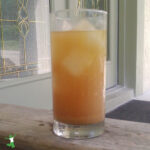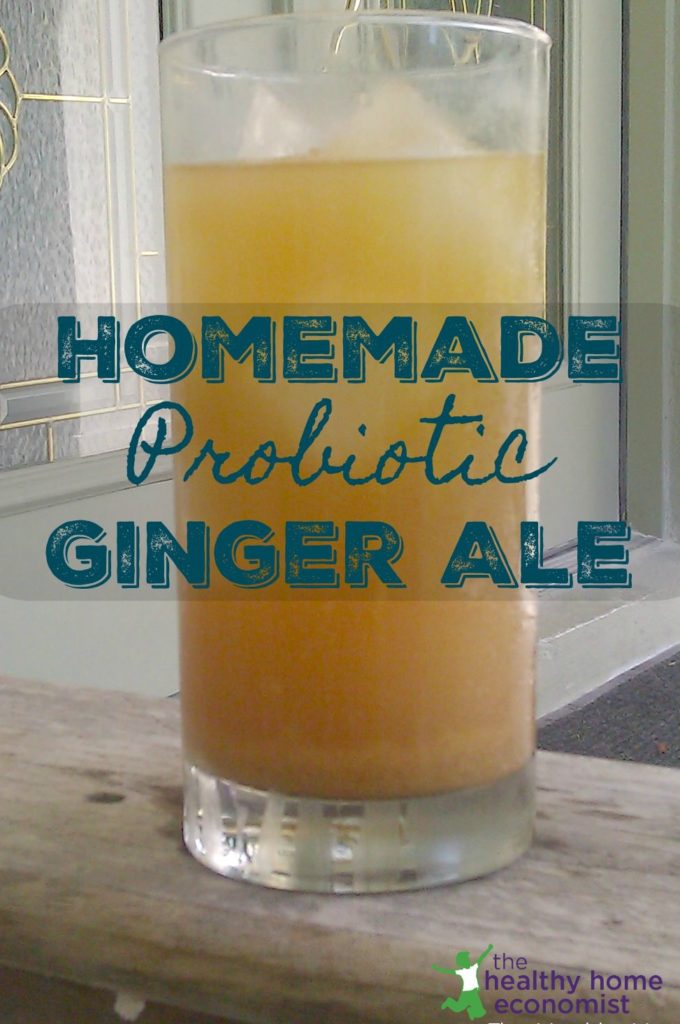Table of Contents[Hide][Show]
A traditional recipe for homemade ginger ale that is lightly fermented with cultured starter, which adds beneficial probiotics and enzymes for digestive benefits as well as delicious taste!

Ginger ale is one of the easiest drinks to whip up at home in a matter of minutes.
The bonus of making ginger ale yourself is that you can ferment it.
This means it is loaded with beneficial bacteria known as probiotics. In addition, traditionally brewed ginger ale is rich in enzymes and has enhanced nutritional value.
Fermentation of grains, fruits and herbs into refreshing and delicious drinks is nearly universal in ethnic cuisines, according to the Nourishing Traditions cookbook, from which this beverage recipe is adapted.
Sadly, the emphasis on convenience in our modern society means that this practice is largely forgotten with the continued popularity of commercial sodas.
Modern versions of ancestral beverages offer no redeeming nutritional benefit.
Worse, the consumption of these sugar-laced or artificially sweetened drinks encourages obesity and other chronic ailments.
Soda really can be healthy! Learning traditional preparation techniques is all that is required.
Preparation Tips
Raw liquid whey is the suggested starter for this beverage and the one I’ve used for decades with great success.
Please refer to this article on the various methods for making raw whey at home for additional details to determine which approach works best for you.
Note that you cannot buy raw whey commercially, although some small dairy farms have it available for purchase.
If a dairy allergy is present, a quarter cup of ginger ale starter or “ginger bug” or water kefir is a simple substitution.
Other ideas for dairy-free fermentation are detailed in the linked article.
While sucanat (pure dried cane juice) is the recommended sweetener, jaggery is a healthy option as well that produces great results.
Raw honey also works for those on gut healing diets such as GAPS. Note that the fermentation will generally occur a bit more quickly using it. I suggest reducing the fermentation time to 1-2 days if using raw honey.
A secondary fermentation using bottles to add additional fizz is optional, but a great idea if you have the time and inclination!

Homemade Ginger Ale Recipe
A traditional recipe for homemade ginger ale that is lightly fermented with cultured starter which adds beneficial probiotics and enzymes to the brew.
Ingredients
- 2 quarts filtered water
- 1/2 cup lime juice freshly squeezed, about 3 limes (preferably organic)
- 2 tsp ground ginger or 2 Tbsp freshly chopped ginger
- 1/3 cup sucanat
- 1 tsp sea salt
- 1/4 cup liquid whey do not use powdered whey
- 1-2 Tbsp raw honey optional
- pinch green stevia powder optional
Instructions
-
Mix all ingredients together thoroughly in a half gallon glass jar. Be sure to leave 1 inch at the top else the soda will get moldy instead of ferment. Affix a secure lid.
-
Leave at room temperature on the counter to culture for 2-3 days and then refrigerate. Homemade ginger ale is mildly fizzy. You can then mix with sparkling mineral water post-fermentation to add even more fizz if desired.
-
Alternatively, you can bottle the homemade soda and leave on the counter for an additional 1-2 days before refrigerating to produce a very fizzy beverage. Be sure to let the bottled soda get very cold before opening. Opening in the sink is a good idea.
-
If the finished homemade ginger ale is not sweet enough for your taste (usually necessary for those coming off a soda habit), add a pinch of optional stevia or stir in a small amount of raw honey.

Other Fermented Beverages to Try!








Could apple cider vinegar be used instead of whey to make ginger ale?
If it is raw, it might work, but I think the taste might be strange. If you try it, let us know how it turns out!
I am on a restricted sugar diet. Do you know how many grams of sugar are left after fermentation?
Thank you!
I haven’t tested it to know for sure.
Cap the jar tightly or use cheesecloth?
Capping tightly is fine.
Can I use fresh ginger? If so how much?
Yes you can. The recipe notes above provides the substitution amount.
Great, thanks. I read them this morning and I think it must be fine as when I taste a bit without the white spots it tastes like a really great sour ginger ale to me!
I made some homemade fermented ginger ale last week (not this recipe but similar), and it is now bottled and has sat out for another 2 days to get it fizzy. However, I’ve just noticed a few little white dots on the surface. Just a couple, but I wonder if it is mould? Should I skim them off and drink anyway or is there a chance it is mouldy and not good for drinking? It’s been left out for 5 days total – 3 in a mason jar and then bottled for 2 days. The lids were loose to avoid exploding glass, but I wonder if something got in? :S
Here are some guidelines. https://www.thehealthyhomeeconomist.com/mold-fermented-foods-what-to-do/
Can you use alternative sweetners like monkfruit, yacon syrup or erythritol blends?
No, you cannot use monk fruit or erythritol as the probiotic starter in this beverage requires a whole sweetener with carb content to feed it as it ferments.
Can I substitute honey or organic sugar for the sucanat?
I haven’t tried it but it would probably work fine. The flavor would be a bit different though especially if you use honey.
We’re enjoying the fermented lemonade. We also drink Haymakers punch.
Do you know if you can use cheesecloth instead of a lid on the jar, like when making kombucha, and it will still ferment?
Yes, it will still ferment.